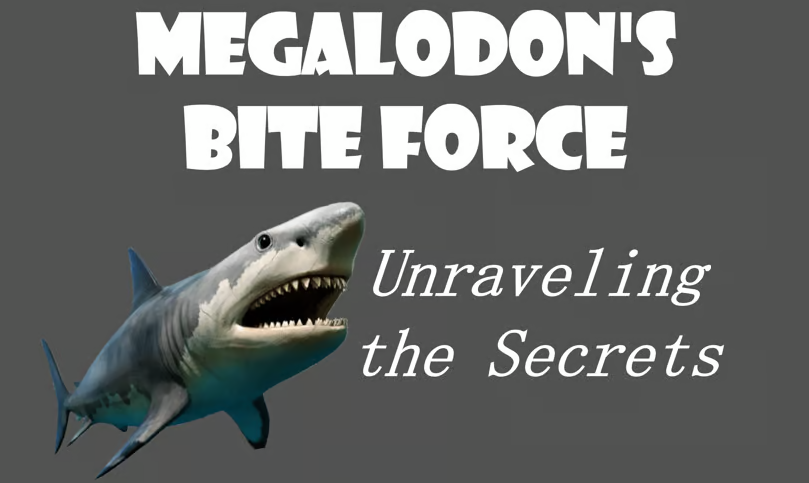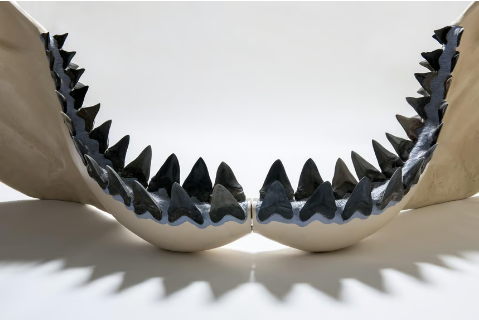
When it comes to ancient marine creatures, few captivate the imagination quite like the Megalodon. This colossal shark, which roamed the oceans millions of years ago, continues to astound scientists and enthusiasts alike. One of the most intriguing aspects of the Megalodon is its awe-inspiring bite force and predatory behavior. In this article, we delve into the jaw-dropping details of the Megalodon’s jaw size, mouth anatomy, teeth, and its role as an apex predator in the ancient seas.
The Megalodon’s Jaw Size and Mouth Anatomy
The Megalodon possessed a truly formidable set of jaws. Its mouth was lined with rows of razor-sharp teeth, each measuring up to 7 inches in length. These teeth, which were triangular and serrated, were perfectly adapted for capturing and slicing through prey with minimal effort. The Megalodon’s jaw spanned an impressive width, allowing it to engulf large marine mammals, such as whales, in a single bite.

Furthermore, the Megalodon’s mouth anatomy was designed for maximum efficiency in hunting and devouring its prey. Its upper jaw was equipped with a series of notches and serrations, which interlocked with the lower jaw, ensuring a secure grip on struggling prey. The jaws were also highly flexible, enabling the Megalodon to open its mouth wide and accommodate prey of varying sizes.
The Mighty Bite Force of the Megalodon
With its massive jaw size and powerful muscles, the Megalodon possessed an unrivaled bite force. While it is challenging to measure the exact bite force of an extinct animal, scientists have estimated that the Megalodon’s bite force could reach a staggering 40,000 pounds per square inch (psi). To put this into perspective, the bite force of a modern great white shark, a close relative of the Megalodon, is estimated to be around 4,000 psi.
This immense bite force allowed the Megalodon to crush the bones and blubber of its prey effortlessly. Marine mammals, such as whales, with their dense bones and thick layers of blubber, were no match for the Megalodon’s powerful jaws. The force generated by the Megalodon’s bite could rupture internal organs, sever limbs, and inflict fatal injuries upon its prey.
The Megalodon as an Apex Predator
The Megalodon’s combination of jaw size, teeth, and bite force firmly established it as an apex predator in the ancient seas. It occupied the top of the food chain, preying on a wide range of marine creatures, including whales, other sharks, and large fish. Its ability to consume such large prey provided it with an abundant source of sustenance.
Unlike modern sharks, which primarily rely on their sense of smell to locate prey, the Megalodon likely used its acute vision and exceptional swimming speed to hunt down its victims. Its massive size and powerful jaws allowed it to launch surprise attacks on unsuspecting marine mammals, using its teeth to inflict devastating injuries.
The Megalodon’s Legacy in Earth’s History

The reign of the Megalodon spanned millions of years, from the early Miocene to the end of the Pliocene epoch. Its existence coincided with a period of rich biodiversity in the oceans, and its presence likely had a significant impact on the marine ecosystem. The Megalodon’s predatory behavior and massive size would have influenced the behavior and distribution of other marine species.
However, approximately 2.6 million years ago, the Megalodon disappeared from the fossil record, leaving behind only fragments of its mighty teeth. The reasons for its extinction remain a subject of debate among scientists. Some theories suggest that changes in ocean temperatures and the decline of its primary prey, such as whales, contributed to its demise.
Conclusion
The Megalodon, with its jaw-dropping bite force and predatory behavior, continues to captivate our imagination. Its massive jaw size, mouth anatomy, teeth, and unrivaled bite force made it an apex predator in the ancient seas. The Megalodon’s legacy in Earth’s history serves as a reminder of the incredible diversity and power that once roamed our oceans. Although the Megalodon is long gone, its memory lives on, inspiring awe and fascination in those who seek to unravel the secrets of our planet’s past.









Leave a Reply